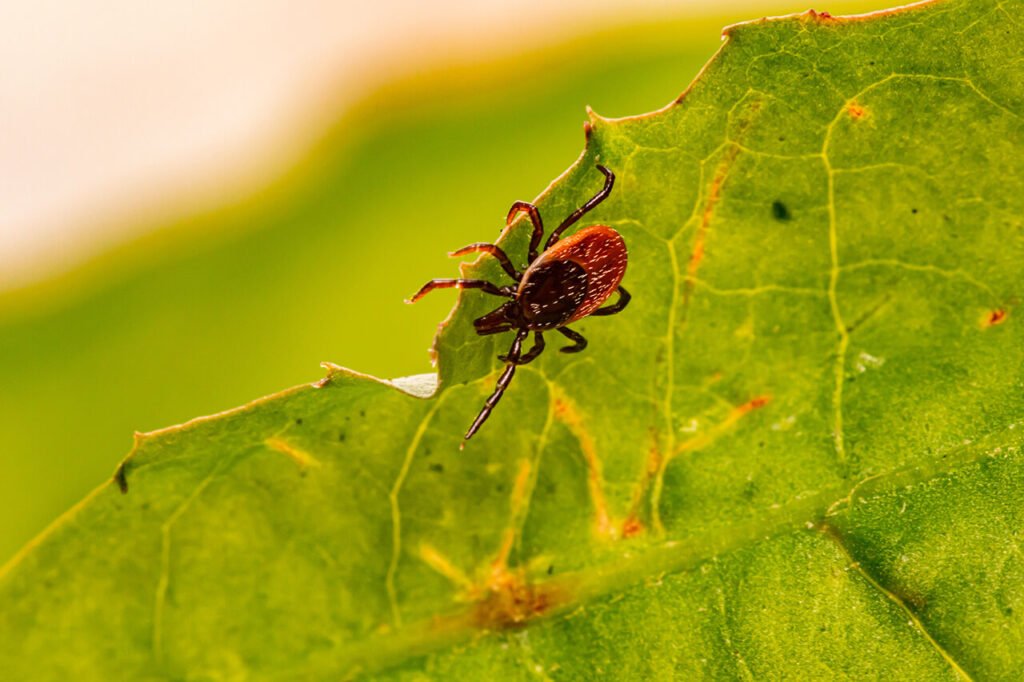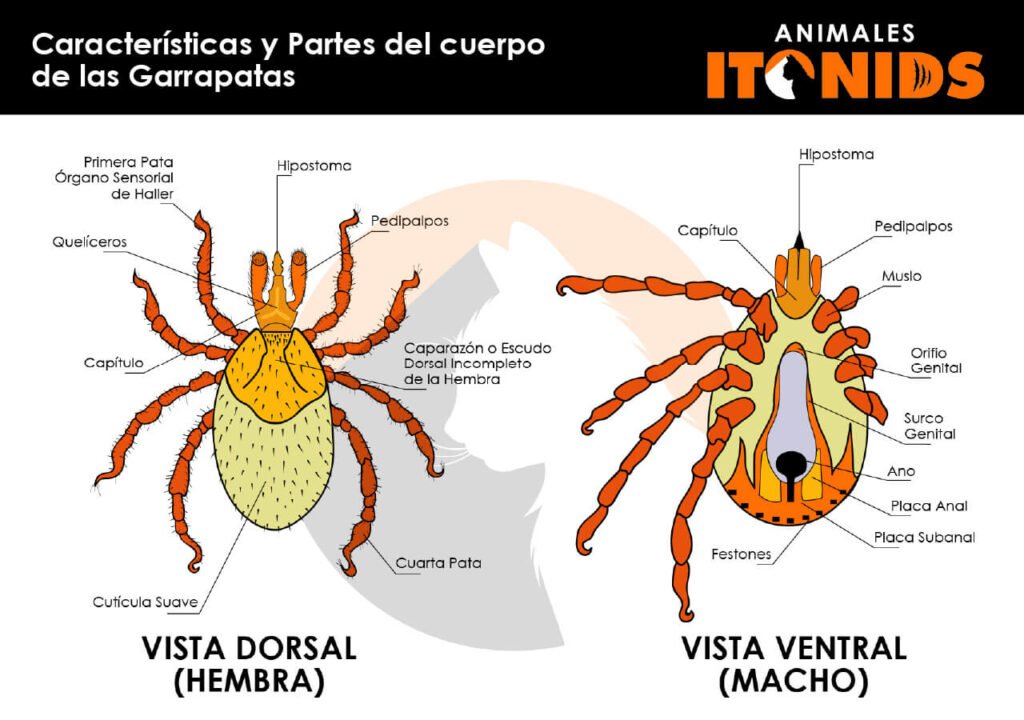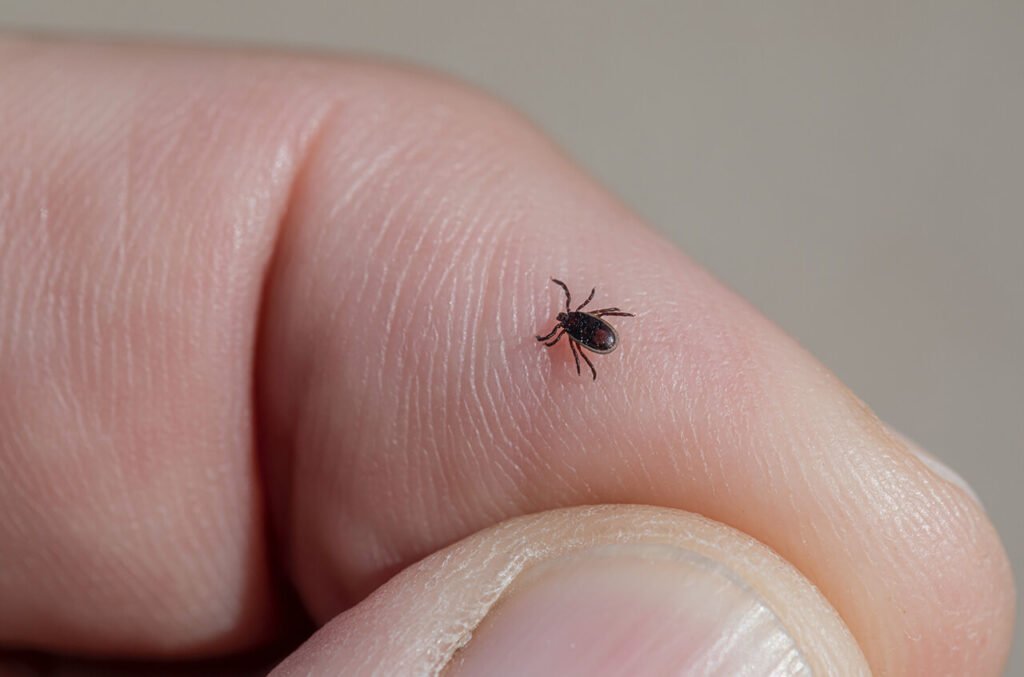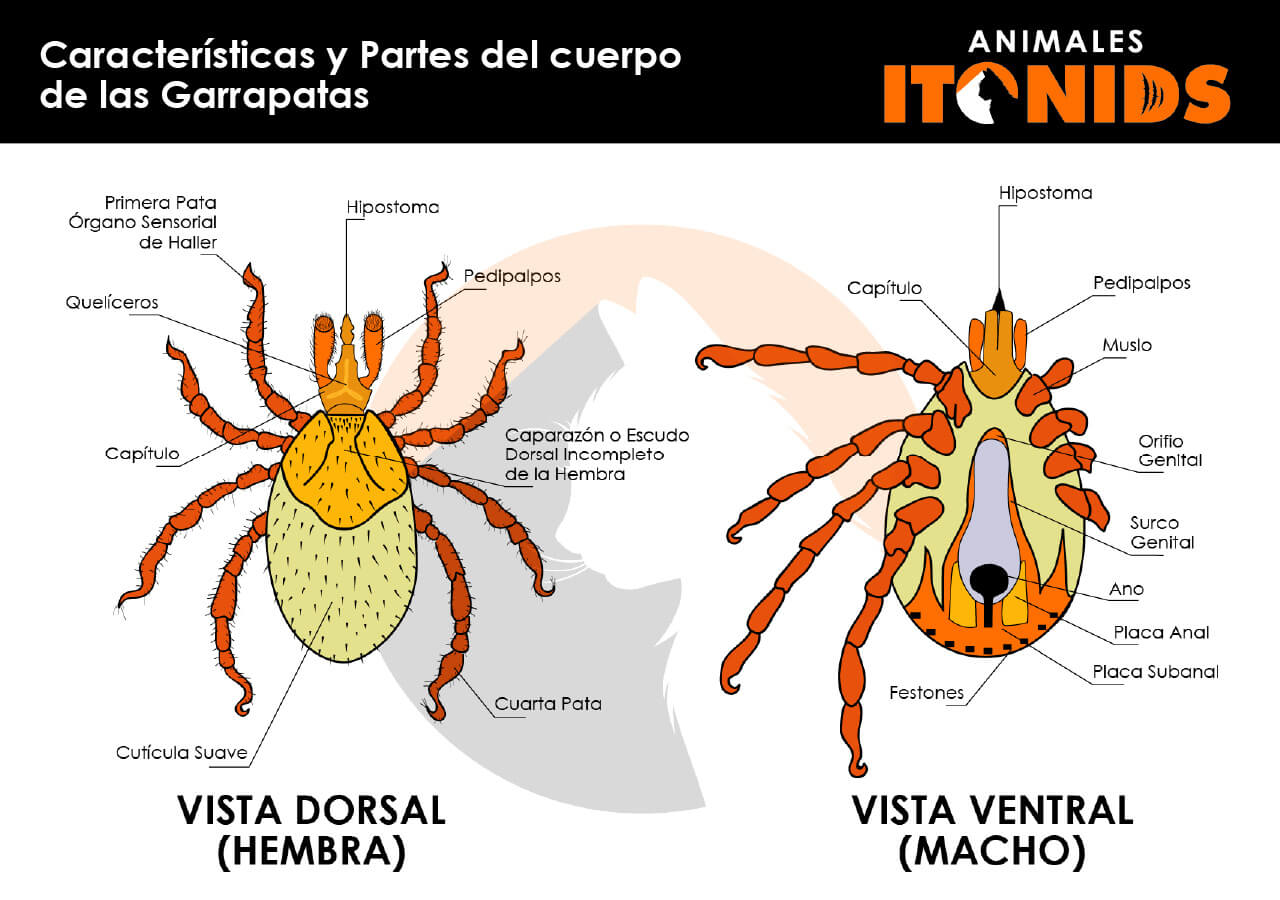In damp places full of trees, shrubs, seeds, leaves, etc., the “Tick” appears, perched on the stems of tall grass, waiting to brush against a host that passes near it, to attach to its skin and thus get its food: blood!
Birds, reptiles, mammals, some amphibians, and even the human body can be an ideal host to feed on, becoming an external parasite and transmitter of dangerous diseases.
What ticks are like, where they come from, what diseases they transmit, and how to avoid them are some of the questions you will find answers to, so don’t miss out! And discover everything about this particular animal.
What are ticks?
They are tiny animals with an unpleasant appearance, characterized by being hematophagous ectoparasites, meaning they live on the skin of an animal host and pierce it to feed on its blood.
Did you know…? Ticks have existed for millions of years, and one of their hosts was a feathered dinosaur!
Scientists from the University of Oxford discovered a fossil tick attached to the feather of a theropod dinosaur (beast foot) and another, filled with blood, which they called “the terrible Dracula tick (Deinocroton draculi)”

What are ticks like?
- Their size varies from four to six millimeters in length.
- They do not have antennas.
- Most exhibit dark colors.
- Their body is flat, oval, but becomes spherical when it has absorbed a large amount of blood.
- Cephalothorax (fusion of head and thorax) and abdomen fused into a single unit, with two regions: anterior (false head) and posterior (idiosoma).
The anterior region or false head (capitulum or gnathosoma) is small and is made up of a series of mouthparts useful for attaching to the skin of its victim: a hypostome and two chelicerae.
The hypostome is a specialized harpoon-shaped piece, composed of curved teeth (denticles); the chelicerae are small structures armed with spines, in the form of hooks.
Additionally, it has two sensory structures (palps) and simple eyes (ocelli), which perceive changes in light.
The posterior region (idiosoma) contains four pairs of legs (except for larvae, which have three pairs) that end in two claws and can be adorned with regular series of rectangular areas (festoons).
It also shows two openings on the abdomen (genital and anal) and a unique sensory pore (Haller’s organ), located on its front legs, with small hairs that allow it to perceive temperature, humidity, odors, and vibrations.
Hard ticks feature a shield on their dorsal part (back).
Did you know…? Thanks to Haller’s organ (sensory pore), the tick perceives the carbon dioxide emitted by a nearby host when breathing and stands on its legs to latch on at the slightest touch.
Digestive system
The tick’s digestive system is simple, mainly formed by the intestine, stomach (central cavity), a series of diverticula (small pouches), and the anus.
Respiratory system
Ticks can breathe through tracheae (small tubes) or through their skin, thanks to some openings (spiracles) located behind their legs (exactly the fourth pair).
Muscular system
Ticks have various types of muscles: flexors, extensors, and muscles that go from the back to the belly (dorsoventral), distributed throughout their body for movement.
Circulatory system
Poorly developed; ticks have a small heart (triangular in shape) and a network of vessels, through which hemolymph (internal fluid) circulates.
Nervous system
Ticks have a brain (synganglion) and sensory organs capable of detecting external stimuli (temperature, humidity, movement…)
Reproductive organs
The male has a pair of testicles and small pouches (spermatophores) containing reproductive cells.
The female has an ovary (horseshoe-shaped), an oviduct (tube for transporting eggs), a genital opening, and an apparatus (Gené’s organ) that produces a protective substance for the eggs.

How are ticks classified?
Ticks are part of the arachnids!
Their Phylum is “Arthropoda (Arthropods),” for having jointed legs, Subphylum “Chelicerata (Chelicerates),” for the shape of their mouthparts (clamp), Class “Arachnida (Arachnids), subclass “Acari (Mites)” for their tiny size, order “Acarina,” and suborder “Ixodida.”
Ticks are classified into three families: Ixodidae, Argasidae, and Nuttalliellidae, encompassing more than 800 species distributed around the world.
Ixodidae (Hard ticks)
Includes about 702 species spread across 13 genera, grouping the hard ticks, so named for having a hard shield or carapace (scutum), covering their entire body (if male) and about a third (if female).
The female is usually larger than the male; their color varies between brown, grey, red, and black, and their mouthparts (chelicerae) are visible.
They are usually diurnal, their lifespan is less than two years, and they can attach to one, two, or three hosts throughout their development, hence they are also called “one, two, or three-host ticks.”
Examples
Lone star tick (Amblyomma americanum), dog tick (Rhipicephalus sanguineus), common tick (Ixodes ricinus), Hyalomma aegyptium, brown tick (Dermacentor nitens)…
Argasidae (Soft ticks)
Groups 193 species in four genera and includes those ticks that do not have a shield on the dorsal surface, with a flexible and rough external cuticle reminiscent of leather. The female and male are the same size.
Their color is usually greyish; they have a pore that allows them to quickly eliminate water while feeding (coxal pore) and their mouthparts are not visible.
They are nocturnal, and depending on the host (commonly birds), they can feed for a few minutes to a few days; they can live up to ten years and their life cycle is slower than that of hard ticks.
Examples
Bird tick (Argas persicus), Carios erraticus, Pajahuello tick (Ornithodoros coriaceus), Argas radiates…
Nuttalliellidae
It is represented by a single female African species, called “Nuttalliella namaqua,” and possesses intermediate characteristics between hard and soft ticks.
How do ticks feed?
Once on their host, the tick chooses the right place to attach and feed, extracting blood thanks to its mouthparts (hypostome and chelicerae) that help pierce the skin and suck the liquid through pumping movements.
While sucking the blood, it secretes saliva that helps fix the mouthparts and contains analgesic and anticoagulant substances, making the bite unfelt and the wound remain open while it feeds.
By enlarging the wound further, it can introduce the capitulum (or false head) into the host’s skin and feed for hours or several days; once full, it detaches.
Did you know…? A tick can accumulate reserves of blood in its digestive apparatus, to feed progressively over several months or even years.
How do ticks reproduce?
The reproduction of most ticks is sexual and occurs on the host; the male holds the female with its legs (by the abdomen) and brings its mouthparts close to the genital opening, where it deposits the spermatophore (a small sac containing sperm) for fertilization.
Did you know…? The Asian tick can self-clone (replicate) in large numbers, asexually, that is, without fertilization, creating identical copies of itself.
Where do ticks lay their eggs?
Once the fertilization process is completed, the female ingests large amounts of blood until she is full; at that moment, she leaves the host and falls to the ground, searching for a moist and protected place to lay her eggs (oviposition).
The process can last between one and three weeks, and once finished, the female dies.
Hard ticks only lay eggs once, while soft ticks are capable of laying eggs multiple times.
Did you know…? A female tick can lay three thousand to ten thousand eggs in a single laying.
Tick life cycle
It occurs in four stages: egg, larva, nymph, and adult. When the egg hatches, the larva is born (with three pairs of legs) that waits, perched on the stems of the grass, until it finds a host to feed on.
After several molts or transformations, it becomes a nymph (with four pairs of legs) and finally, reaches its adult size and sexual maturity.
Where do ticks live?
They live all over the world, adapted to most of the planet’s terrestrial environments (except the large deserts), including coastal areas of Antarctica.
Hard ticks can be found in leafy areas (tall grass, fallen leaves, and weeds); soft ticks are regularly found in animal burrows, nests, or caves.
During the winter months, most species hibernate (sleep) due to the low temperature, becoming more active in spring.
Where do ticks live in a house?
Ticks can reach your home via pets or your body! Even a bouquet of freshly cut flowers from the garden can also be a carrier.
After a walk through the garden, park, or another place, or when pets interact with other infested animals, it’s possible that a tick has attached to their fur, our clothes, or skin, lodging in the groin, behind the ears, on the neck, armpits…
Once at home, they can live for about nine months if they find damp areas, rotting wood, carpets, cracks in the walls… that facilitate their reproduction.
What do ticks look like on dogs?
An annoying itch that forces them to scratch insistently are signs that alert to the possible presence of ticks on dogs, and they are usually found around their entire body: on their neck, ears, head, between the fingers, and even moving through their fur.
You can easily see them by performing an inspection between the fur and the skin.
Diseases transmitted by ticks
Although most tick bites are not serious, certain species (such as the black-legged tick) can transmit bacteria and various diseases, becoming dangerous enemies for animals and humans.
Lyme disease (Borreliosis)
Caused by the “black-legged tick” that inhabits deer, carrying the bacteria “Borrelia burgdorferi,” causing complications such as arthritis, heart disorders, and nervous system disorders.
Its first symptoms are similar to the common flu: fever, headache, chills, fatigue, muscle aches, as well as redness in the affected area; treatment is based on antibiotics.
Ehrlichiosis
Disease caused by the “lone star tick” thanks to bacteria that belong to the “rickettsiae” family; its symptoms appear a week after the bite, causing fever, headache, nausea, and muscle pains…
In the most severe cases, it can cause seizures, lung damage, and death. Treatment focuses on antibiotics.
Anaplasmosis
Disease transmitted by the “black-legged tick,” which can carry the bacteria “Anaplasma phagocytophilum”
Symptoms usually manifest seven days after the infection: fever, chills, abdominal pain, cough, and in some cases, bleeding; presenting neurological complications; the use of antibiotics is the best treatment.
Babesiosis
Disease produced by the “black-legged tick” infected with the parasite “Babesia,” symptoms can include general malaise, fatigue, chills, fever… or feel nothing (asymptomatic); sometimes it can be lethal, especially in the elderly. It is combated with antibiotics.
Encephalitis
It is a disease transmitted by the “common tick (Ixodes ricinus)” affecting the central nervous system; symptoms usually appear a week after the bite of an infected tick with the virus (Flavivirus).
There is no specific treatment, so preventive measures and vaccination are recommended.

Did you know…? The bite of the lone star tick (Amblyomma americanum), besides transmitting diseases, can cause a striking phenomenon: its saliva can
How to remove ticks?
Once you’ve discovered the presence of ticks on your pet or your body, it’s important to remove them as soon as possible. For this, you can use tweezers for their removal, and cotton with alcohol (or iodine) for disinfection.
The best way is to place the tweezers as close as possible and pull it outwards; if you don’t have tweezers, you can use your hands (covered with gloves), try not to crush it, as part of it can remain adhered to the skin and cause a more serious infection!
Once you manage to remove it, disinfect the affected area.
Home remedies for ticks
There are very useful and easy-to-prepare home remedies that will help you eliminate this unpleasant arachnid:
Citrus fruits
Boil water with peels of lemon, orange, or any citrus fruit, and clean the house areas, spray the cold mixture on your pet, being careful with their eyes.
Natural oils
Rosemary, cinnamon, almonds… are natural repellents; you can mix their oils and clean the house spaces and furniture with a clean cloth; if you have a pet, this mixture is effective, impregnating its body with the mixture.
Baking soda
Mixed with salt, vinegar, and warm water, is useful for eliminating ticks, both from spaces and pets (spraying the mixture on their body).
Eucalyptus leaves
Their smell repels ticks; you can leave leaves scattered in different places of the house, but avoid your pet (if it is a dog) from eating them, as it would cause stomach discomfort.
How to avoid ticks?
If you go for a walk in the forest, or places where you have contact with tall grass and weeds, make it a habit to wear protective clothing (long sleeves, pants…) in light colors, as well as tick repellent.
If you have a garden at home, constantly mow the lawn and clean the areas in general.
If you have pets, maintain good hygiene, with antiparasitic solutions in their bath, powders, pipettes, and antiparasitic collars, which will allow you to constantly check and brush them, and don’t forget to take them to the vet!

